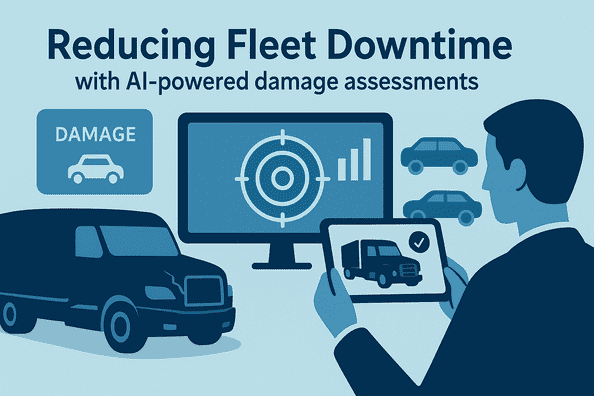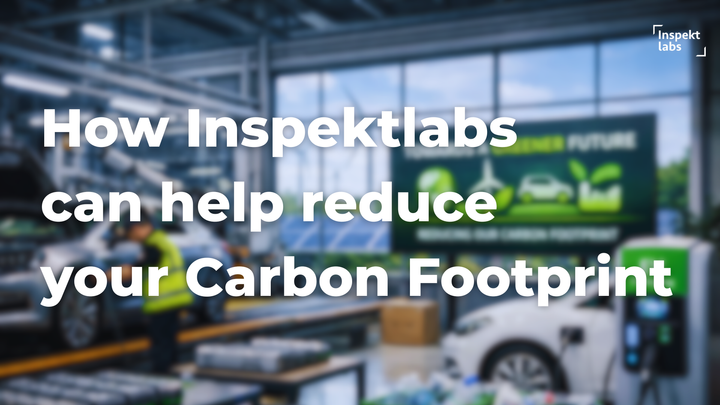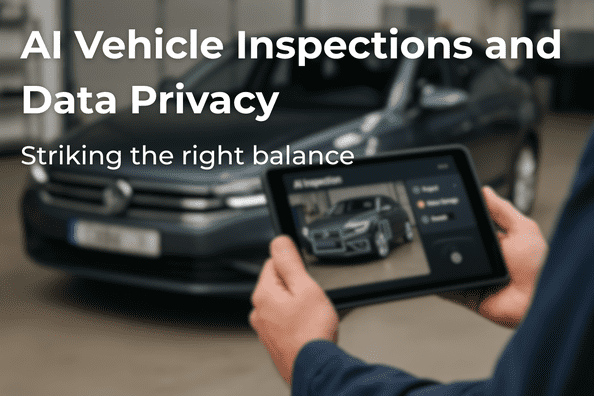Reducing Fleet Downtime with AI-powered damage assessments
Fleet Downtime can have major repercussions for companies that rely on vehicles, whether for logistics, car rentals, leasing, or last-mile delivery. In this blog, we discuss how AI-powered inspections can help reduce Fleet Downtime to optimize business goals.

For companies that rely on vehicles, whether in logistics, car rentals, leasing, or last-mile delivery, fleet downtime is one of the biggest threats to profitability. Every hour a vehicle is out of service means lost revenue, delayed deliveries, unhappy customers, and higher operational costs.
Fleet downtime for a business could result in -
- Lost productivity - Fewer vehicles on the road means reduced operational capacity
- Missed opportunities - Delayed deliveries and service appointments can lead to contract penalties or lost clients
- Higher costs - Idle vehicles still incur expenses like insurance, storage, and depreciation.
One of the most common (and preventable) causes of downtime is a slow and inconsistent vehicle damage inspection process. Traditional vehicle inspection methods rely heavily on manual checks, which are time-consuming, inconsistent, and prone to errors.
With competition increasing and customer expectations rising, fleet operators need a faster, more accurate, and scalable solution. This is where AI-powered damage assessments come into play.
What is AI-powered damage assessment?
AI damage detection uses advanced computer vision and machine learning models to automatically detect, classify, and evaluate vehicle damage from simple photos or videos. This technology can be implemented in multiple ways -
- Mobile-based inspections - Drivers or staff can capture photos and videos from their smartphones via the vehicle inspection app. The AI then processes these images to detect dents, scratches, cracks, or broken components.
- Fixed-camera systems - Vehicles drive through inspection lanes equipped with cameras, allowing for automated vehicle inspections without human involvement.
The output is a vehicle condition report generated in seconds, offering
- A detailed breakdown of detected damages.
- High-resolution photo evidence for verification.
- A consistent and unbiased damage record.
This eliminates the variability of human inspections while ensuring every vehicle is assessed to the same standard.
How AI reduces Fleet Downtime
AI-powered vehicle damage inspection directly impacts fleet availability by streamlining the inspection-to-repair process. Here's how -
#1 - Instant Inspections
Manual inspections can delay vehicle deployment by hours or even days. AI-powered systems deliver near-instant fleet inspections, meaning vehicles can be cleared for use almost immediately if no major issues are found.
#2 - Faster Repairs
When damage is detected, the AI system provides detailed reports that can be sent directly to the workshop. This allows repair teams to prepare parts, allocate resources, and start work without delays caused due to lengthy manual evaluations.
#3 - Reduced Disputes
Disagreements about damage responsibility, whether between departments, with customers, or with vendors, can stall repairs and take vehicles out of circulation. Automated vehicle condition reports backed by photographic evidence drastically reduce the scope for disputes.
#4 - Fewer Rechecks
Since AI damage detection delivers consistent results, there's less need for double-checking or second opinions, allowing repair workflows to move faster.
#5 - Real-time alerts
If damage occurs during use, automated vehicle inspection systems can flag it immediately. This enables preventive maintenance before the issue gets worse, avoiding breakdowns that cause longer downtime.
#6 - Predictive maintenance
By analyzing historical damage and wear patterns, AI can help predict whether a vehicle part is likely to fail. Fleet managers can schedule maintenance proactively, ensuring vehicles remain in the best condition and minimizing surprise downtime.
Operational Benefits for Fleet Management
Beyond just reducing downtime, AI-powered vehicle damage inspections deliver several strategic advantages for Fleet operators -
- Higher uptime - Keeping more vehicles on the road increases operational capacity without expanding the fleet size.
- Better scheduling accuracy - Quick inspections mean accurate deployment schedules and fewer delays.
- Optimized repair workflows - Repair shops can pre-plan tasks based on inspection reports, reducing turnaround time.
- Improved resale value - Maintaining detailed vehicle condition reports helps preserve asset value for future resale or trade-in.
- Data-driven decision making - Analytics from fleet inspections provide insights into recurring issues, helping managers decide whether to repair or replace vehicles.
Real-world applications
AI-driven vehicle inspections are already being adopted across industries
- Car Rental companies - Instantly inspect returned vehicles to speed up turnaround times, reduce disputes over damage, and maximize fleet utilization.
- Logistics & Fleet Operators - Perform routine fleet inspections with minimal manpower, ensuring vehicles are always ready for the road.
- Leasing companies - Automate end-of-lease inspections to quickly assess wear and tear, reducing manual processing time.
- Used car Dealerships - Evaluate trade-ins within minutes, ensuring accurate pricing and faster decision-making
Long-term ROI
The financial benefits of implementing automated vehicle inspections extend far beyond just saving time -
- Higher fleet utilization - Reduced downtime means each vehicle generates more revenue over its lifecycle.
- Lower labor costs - Fewer man-hours are spent on manual inspections.
- Reduced damage-related losses - Early detection prevents minor vehicular issues from becoming major, costly repairs.
- Enhanced customer trust - Transparent, photo-documented vehicle condition reports improve credibility with clients and customers.
The future of Fleet Inspections
In the coming years, AI damage detection will evolve even further, integrating with telematics, IoT sensors, and predictive analysis. Fleet managers will be able to receive real-time alerts for even minor damage, allowing proactive scheduling of repairs before vehicles completely break down.
This isn't just adopting a new technology; it's about future-proofing your operations. Companies that embrace AI now will have a competitive edge, delivering faster, more reliable services while keeping operational costs under control.
Conclusion
AI-powered vehicle damage inspections are no longer just a "nice-to-have"; they're becoming an industry standard.
With the ability to cut inspection times from hours (or even days) to a few minutes, reduce disputes, and improve repair turnaround, AI technology offers fleet operators a clear path to higher efficiency and profitability.
As the fleet grows larger and customer expectations for speed and reliability increase, automated vehicle inspection is set to become the cornerstone of modern fleet management. Investing in this technology means your fleet won't just keep up, it'll lead the way.
Wish to upgrade your current Fleet Management process and reduce the overall downtime? Contact us now!



